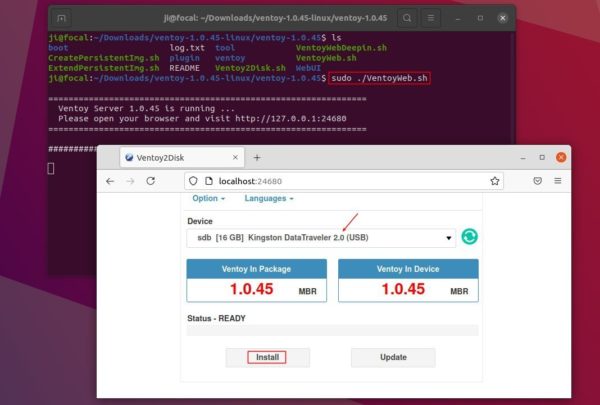
- Ventoy for linux how to#
- Ventoy for linux install#
- Ventoy for linux iso#
- Ventoy for linux free#
- Ventoy for linux windows#
It should be noted that the partition style of the disk will not change after non-destructive installation. For example: sudo sh Ventoy2Disk.sh -i -n /dev/sdb Ventoy2Disk.sh add -n option used with -i or -I. The partition style of the disk will not change after non-destructive installation.

It should be noted that, when you do non-destructive installation, the MBR/GPT partition style selected in the menu will not take effect.
Ventoy for linux install#
Select the device and click Options -> Non-destructive Install menu as follows:
Ventoy for linux free#
There must be some free space in the 1st partition. If partition 1 is EXT2/3/4, then e2fsprogs package must be installed.ģ.2.4. If partition 1 is NTFS, then ntfs-3g package must be installed. The 1st partition must contains NTFS or EXT2/3/4 filesystem. The 1st partition must start at 1MBģ.2.3. There must be a free partition table to use in the disk.ģ.2.2. Ventoy need to get some information according to the drive letter.ģ.2.1. The 1st partition must have a drive letter. It's also OK if you already has enough unused space (32MB+) after the 1st partition.(Then we don't need to shrink the 1st partition anymore).ģ.1.5. The non-destructive shrink need some free space.
Ventoy for linux windows#
This is because Windows APIs only support to shrink NTFS.įor FAT32/exFAT you can use DiskGenius or other third-part tools to shrink the partition before non-destructive installation.ģ.1.4. The 1st partition must contains NTFS filesystem. In Windows, the 1st partition is start at 1MB by default.ģ.1.3. The 1st partition must start at 1MBīoth MBR and GPT must meet this requirement to match Ventoy's disk layout. Ventoy need to insert a new VTOYEFI partition, so it will occupy a partition table.įor MBR partition style, if there already exist 4 partitions in your disk, then it can not do non-destructive installation.įor GPT partition style, if there already exist 128 partitions in your disk, then it can not do non-destructive installation.ģ.1.2. There must be a free partition table to use in the disk. Normally the following conditions need to be met:ģ.1.1. Ventoy will automatically check the device and will not do the non-destructive installation if some conditions cannot be met.

The mechanism of nondestructive installation is very simple. tar.gz file corresponding to Ventoy for Linux.
Ventoy for linux how to#
To show how to install Ventoy using Linux, I’m going to use Linux Kamarada 15.1.
Ventoy for linux iso#
You can not do and don't need nondestructive installation if the disk already installed with Ventoy, the menu will be disabled. During boot, Ventoy searches all the directories and subdirectories recursively to find all the ISO files inside the USB drive. So don't use it on a disk which contains MBR bootloader.ģ. The MBR and the first 1MB area before the 1st partition will be overwritten. Just create the bootable USB device once and copy as many as OSes you want in the drive. It currently supports around 720+ ISO images including Linux, BSDs, Windows, VMware ESXi, and Citrix XenServer etc. Ventoy will try to ensure the safety of existing data, but it is strongly recommended to back up first for very important data.Ģ. Ventoy allows you to painlessly create Linux, Unix, and Windows bootable USB mediums from commandline as well as graphically. Since 1.0.59, Ventoy provides experimental support for non-destructive installation in Ventoy2Disk.exe.ġ. In some cases you may have put a lot of files in the USB stick and don't want to backup and restore data. Not to say that the average user wouldn’t reap the benefits of this piece of software.By default Ventoy will format the USB stick when install. Ventoy is a great piece of software, specially designed for people that boot into the different OS or reset their machine rather frequently. iso files to the Ventoy partition.ĭownload the installation file, and extract it. VentoyGUI.x86_64.Ĭhoose the desired device and click Install. Navigate to the extracted folder, and execute.

Note: Check the Linux GUI Support page x86_64/i386/arm64/mips64 support.ĭownload from Ventoy Releases Github page. For the instructions on the other modes, visit the official page for more information.

The executables for both Windows and Linux can be found on the Ventoy Releases GitHub page.įor Linux, I will be going through method 1 in GUI mode. The method of the installation follows the do following structure: The UI between Windows and Linux don’t differ, but the execution is slightly different for both the operating systems. In the latest version, Secure Boot capability is now supported. iso can be replaced, and Ventoy can be easily updated using the installer. iso in the drive as long as it doesn’t exceed the size of the USB. Once Ventoy installs, the user can then transfer multiple. This means that the user doesn’t need to format the drive every time you need to boot into a different OS. Doing so, allows the user to incorporate different. What makes it different from other tools like Rufus, UNetbootin, or even balenaEtcher is that it does not extract the. Ventoy is an open-source bootable USB drive-making tool for.


 0 kommentar(er)
0 kommentar(er)
